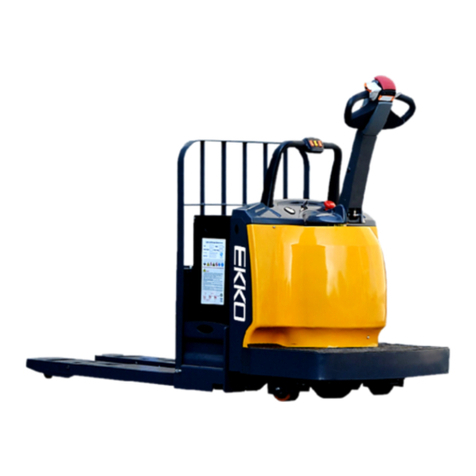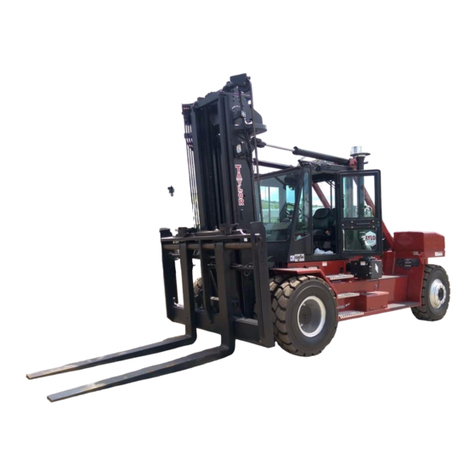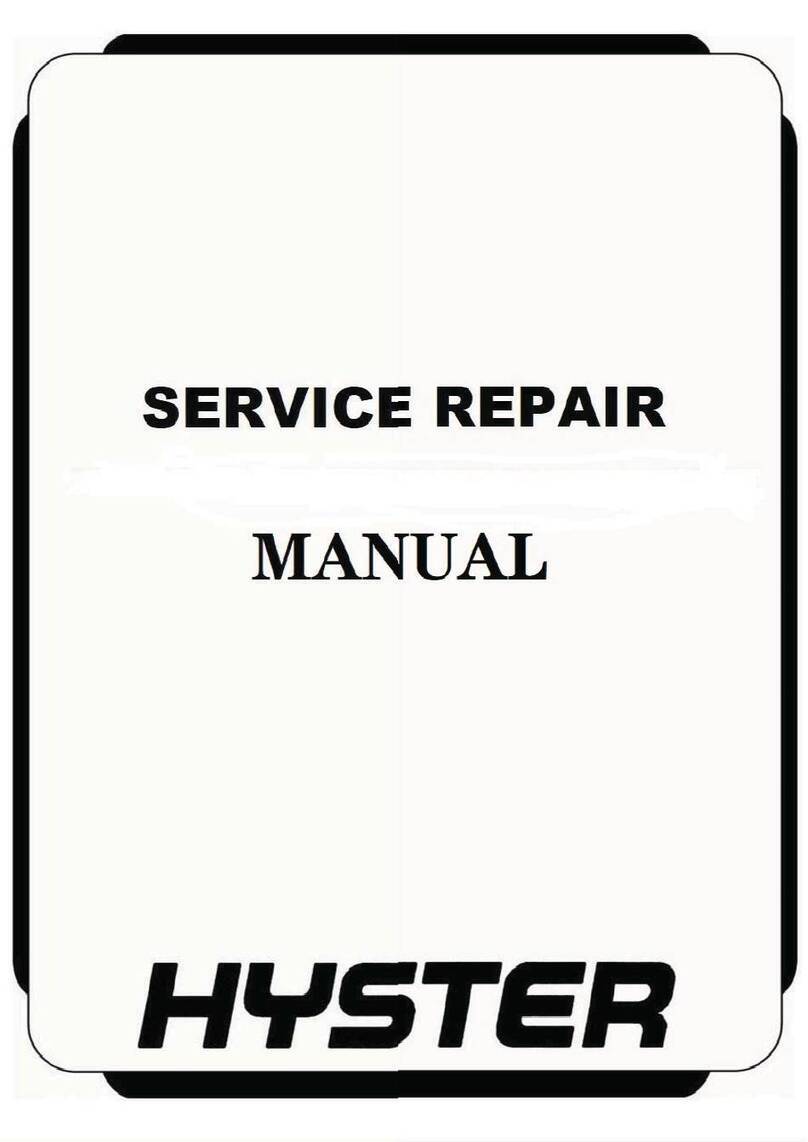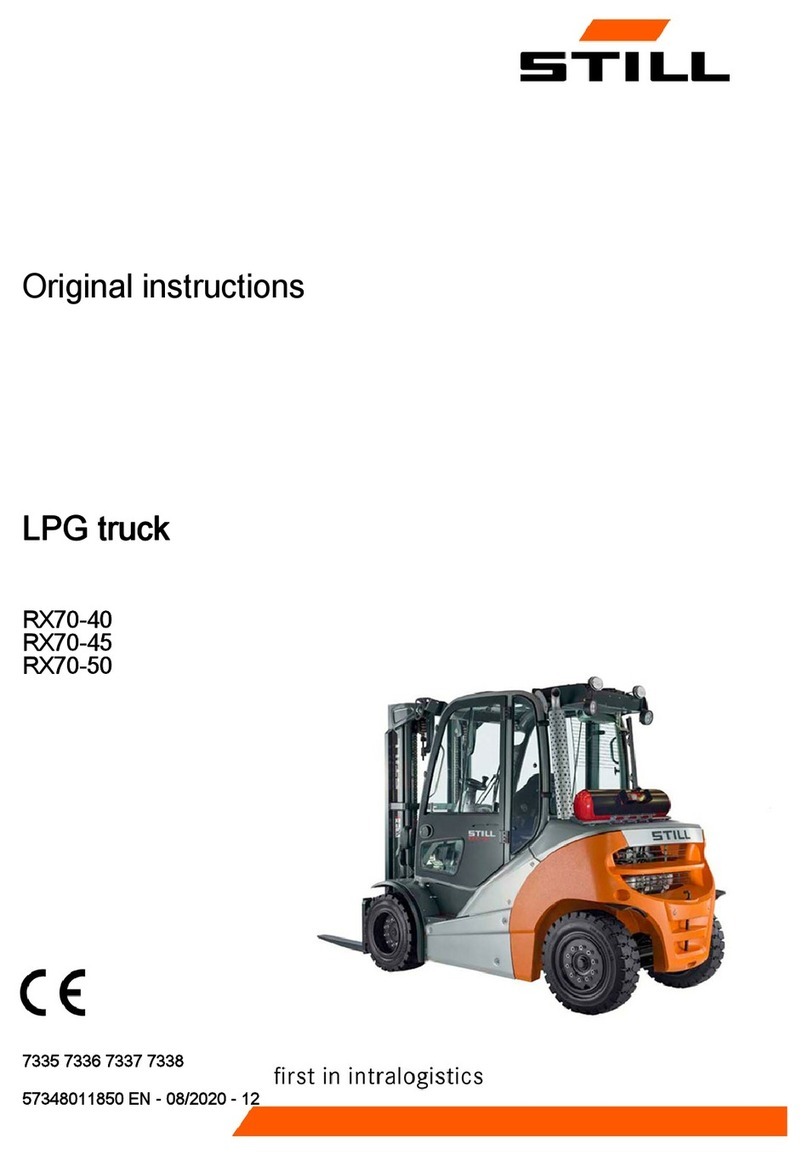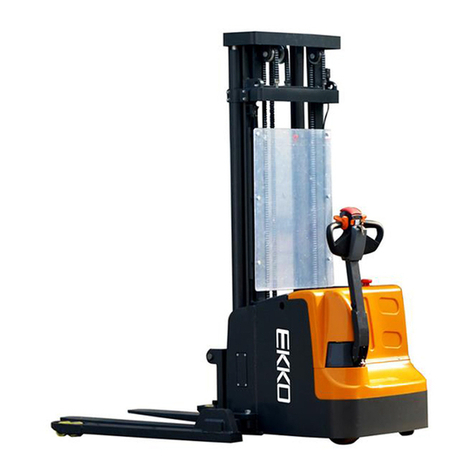Nakanishi KOLEC FX15WT User manual

Walkie Counterbalanced Forklift
Instruction Manual
Nakanishi Metal Works Co., Ltd.
Before operation, inspection and maintenance of this forklift, be sure to read this
instruction manual to understand the contents thoroughly. Keep this instruction
manual in place where you can quickly access it.
FX15WT

Nakanishi Metal Works Co., Ltd.
Thank you for purchasing “Walkie Counterbalanced Forklift”. This instruction manual describes
proper handling method and daily inspection/maintenance method for the counterbalanced forklift.
Before using this forklift, please read this instruction manual to understand the instructions given in
the manual thoroughly. Keep this instruction manual in place where you can access it anytime. If
you have uncertainty during use of the forklift, or if a trouble occurs with this forklift, this instruction
manual serves as a help. We hope you use this forklift safely for a long period.

1. Part Names and Specifications
2. Basic instructions
Identification plate
Purpose of use
Operating conditions
Safety/protection devices
Warning label
3. Safety Precautions
Instructions classified as DANGER, WARNING and CAUTION
4. Handling Procedure
Load capacity
On receipt of this forklift
Startup
Traveling
Raising/lowering the fork and tiling the mast backward
Loading/unloading cargo
Safety devices
At end of work
Charging
Battery maintenance
5. Inspection and Maintenance
Preoperational inspection
Monthly inspection (Voluntary inspection)
Periodic replacement parts
Troubleshooting
Electric circuit diagram
6. Transportation
7. Disposal
47
49
52
54
Table of contents
32
33
36
37
38
43
46
46
5
6
6
24
24
25
26
27
1
3
3
3
3
4
56
57

[1] Switch key: 2 pieces [2] Battery charger [3] Fuse
1
(Back)
1. Part Names and Specifications
(1) Part names
(2) Accessories
Tilt operation switch
Pinch accident
prevention switch
Horn button
Lift operation switch
Travel knob Speed change switch
Battery discharge meter
Hour meter
Emergency stop
button
Steering handle
Battery cover
Drive wheel (front)
Load wheel (rear)
Mast
Chain
Cylinder
Backrest
Fork

1. Part Names and Specifications
Maximum load
Load center
Lifting height
Backward tilt angle
Minimum turning radius When handle is upright
Overall length When handle is upright
Overall width
Wheelbase
Fork length
Fork overall width
Single fork width
Weight Including battery
Drive wheel Made of urethane
Load wheel Made of urethane
Battery voltage
Battery capacity 5HR
Battery charger
Drive motor
Drive control
Hydraulic motor
Hydraulic control
2
mm
mm
Unladen
Under load
No load
mm
mm
kg
mm
mm
°
mm/s
mm/s
km/h
km/h
UnitModel
Lifting speed
Driving speed
Laden
Remarks
FX15WT
1,500
500
35 - 2,500
5
60
140
3.2
mm
mm
mm
mm
mm
kg
mm
890
Minimum upper stroke end
Maximum lower stroke end
Overall height
3.8
1,380
2,430
2,200
AC motor control
Automatic battery charger
φ
150 x 80, 2 pieces
24
201
1,700
φ
245 x 100, 1 piece
3,055
1,825
1,800
100
630 - 400
920
1,120
mm
V
Ah
---
W
---
W
--- Knob-type chopper control
(3) Specifications

Allowable temperature: 5°C to 50°C, Allowable humidity: 20% to 80%
No flammable gas, No flammable liquid
Indoor
Rigid, hard and flat floor
3
The operating environment of this forklift should be in the following range: Using this forklift in other than the
following temperature/humidity range may result in machine performance deterioration. Using this forklift in any
condition out of the specified operating environment conditions may result in unexpected safety risk.
This forklift is intended for the following purpose. This forklift is prohibited from use for other than the intended
purpose (load sling, worker elevation, etc.).
Purpose of use of this forklift:
This forklift is intended for load lifting/lowering and transfer operations using the fork, etc. on a rigid, flat floor in a
building.
Manufacturer, model and serial No. of this forklift are indicated at the following position of the vehicle body.
When you issue a repair order, be sure to inform us of the model and serial No. of your machine.
Temperature/Humidity
Ambient conditions
The following are basic instructions that you should learn about use of this forklift, and those prescribed in laws
and ordinances to ensure safe use of the forklift.
For safety instructions that are not included in this section, refer to “2. Safety Precautions”.
(Use this forklift in the range of 0°C to 50°C, even if the above temperature range is
not available.)
Position of
identification plate
Indoor/Outdoor
Floor condition
2. Basic instructions
Identification plate
Purpose of use
Operating conditions
KG
KG
Vehicle Model
Maximum Load
Vehicle Weight
Serial Number
NKC COMVEYORS., L D.

2. Basic instructions
4
6
No. in the drawing
2
When an operator is almost pinched between the
handle and a wall, this switch is pressed with the body,
so that the forklift moves backward to prevent the body
from being pinched.
(Even if this switch is pressed while the forklift is
moved backward, it does not move forward.)
The guard prevents the operator’s feet from entering
the bottom of the vehicle, so that the feet will not be
caught by the vehicle body or front wheel.
When the hydraulic flow rate becomes abnormally
large, the shutoff valve is activated to limit the flow rate
to prevent abrupt fall of the fork.
When slinging the vehicle body, sling hooks can be
attached to the eyeholes. Using the eyeholes enables
sling work to be securely conducted.
This forklift is equipped with the following safety devices and additional protection devices. During operation of the
forklift, these devices must not be removed.
Pressing the emergency stop button turns OFF the
power supply.
When you reset the emergency stop button, be sure to
ensure safety in advance.
Pressing this button turns on the horn.
Appearance
Guard
Excessive flow shutoff
valve
3
Alarm (Horn)
Sling eyehole
Pinch accident
prevention switch
1
Safety/protection device
Emergency stop button
4
5
Safety/protection devices
12
3
4
5
6

2. Basic instructions
5
The following warning labels are attached to the FX15WT body. Use the forklift carefully by following the
instructions given on the warning labels. If any of the warning labels is difficult to read due to stain or damage,
replace it with a new one so that the warning labels are kept readable.
Warning label
Allowable load curve
Operation handle side of Mast Front of battery cover
WARNING
WARNING
Take care when stcking.
No overloading The load
capacity and lifting
height should be within
the rated
WARNING
WARNING

6
DANGER
WARNING
Improper handling of the forklift may result in imminently hazardous conditions involving
death or serious injury.
Improper handling of the forklift may result in hazardous conditions involving death or
serious injury. Also, slight injury and property damage may occur at considerably high
possibility.
In this instruction manual, situations that may result in accidents from improper handling of the forklift are classified
into the following three categories:
CAUTION Improper handling of the forklift may result in hazardous conditions involving injury, and
serious injury at less possibility. Also, it may result in property damage.
Before use, read this instruction manual to understand the contents thoroughly.
Failure to read and understand the contents of the instruction manual causes
improper handling of the forklift, which may result in accidents involving serious
injury and burns.
Before start of work, make a work plan, and notify it to people around the forklift
operating area. If the forklift is operated without preparation of a work plan or
without notification of the work plan to surrounding people, the forklift may collide
with surrounding people, who may suffer injury.
Do not use this forklift for other than the principal purpose.
Using the forklift for any purpose other than the intended purpose may result in
unexpected hazardous conditions, causing a serious accident.
3. Safety Precautions
Be sure to read this instruction manual before use.
WARNING
Make a work plan, and observe the plan thoroughly.
Do not use the forklift for other than the principal purpose.
Instructions classified as DANGER, WARNING and CAUTION
■
■■
■Before use
WARNING
WARNING

3. Safety Precautions
7
During work with the forklift, appoint a work leader. The work leader should
give directions for work according to a work plan. If a work leader is not
appointed, risk of accident may increase, because of insufficient
association with surrounding work.
Modification of the forklift may deteriorate performance and safety of the
forklift.
If modification is required, please consult the manufacturer.
Do not attach any part to the forklift other than the accessories allowed by
the forklift manufacturer. Failure to observe this instruction may lower
stability and strength required for safety
When the forklift is left unused, remove the key from the key switch, and
keep it. If the key is left in the switch, an unauthorized person or a person
who has not been familiarized with operation of this forklift may operate
the forklift, resulting in an accident.
If the forklift is used in a fault or abnormal condition, it may result in
collision, cargo fall or forklift overturn accidents because the forklift cannot
be normally operated due to the fault. If a fault or abnormality is found with
the forklift, repair it immediately.
When lowering the fork from the traveling position to the operating
position, hold the fork, and lower it carefully. If you handle the fork roughly,
your hand may get pinched with the fork, resulting in injury such as bone
fracture and bruise.
WARNING
Appoint a work leader.
Remove the key when the forklift is left unused.
When restoring the fork from the traveling position, handle it
carefully.
Do not use a forklift in a fault condition.
Do not attempt to modify the forklift.
Do not attach any part other than the genuine accessories.
WARNING
WARNING
DANGER
DANGER
WARNING

3. Safety Precautions
8
Do not operate the forklift under influence of a medicine that induces drowsiness.
If you operate the forklift under influence of such a medicine, operation error or
operation delay may occur, resulting in a collision accident, etc.
Wear clothes appropriate for work with the forklift. If you wear untidy clothes
during work, a part of the clothes may get caught with the vehicle body or may
hinder operation of the forklift. This causes operation error or operation delay,
resulting in collision and cargo fall accidents.
Overwork may induce inattention during operation of the forklift, causing
operation error or operation delay, which may result in a collision accident, etc.
Be sure to wear protective cap and safety shoes. Otherwise, if a cargo fall, it may
collide with or pinch your feet. If the forklift overturns, you may suffer serious
injury.
If you operate the forklift with wet hands or hands stained with oil, the hands slip,
which may result in collision and cargo fall accidents.
Wear protective cap and safety shoes.
Do not operation the forklift under influence of a medicine that
induces drowsiness.
Do not operate the forklift in overwork condition.
■
■■
■Instructions for operator
Do not operate the forklift with dirty hands.
Wear clothes appropriate for forklift work.
WARNING
WARNING
WARNING
CAUTION
WARNING

3. Safety Precautions
Operating the forklift under influence of alcohol may result in collision,
cargo fall and overturn accidents.
Do not operate the forklift while using a cellphone or smartphone. Such an
action induces inattention, and causes operation error or operation delay,
which may result in collision and cargo fall accidents.
Before operation of the forklift, practice it thoroughly, so as to be
familiarized with this forklift. If you operate the forklift before getting
familiarized with it, operation error or operation delay may occur, resulting
in a collision accident, etc.
If you operate the forklift at any position other than the position that
enables all operations immediately (normal operating position), operation
error or operation delay may occur, resulting in a collision accident, etc.
9
Before operation, be familiarized with this forklift.
Do not operate the forklift under influence of alcohol.
Do not operate the forklift while using a cellphone or smartphone.
Do not operate the forklift at any position other than the normal
operating position.
WARNING
WARNING
WARNING
WARNING

3. Safety Precautions
Do not operate the forklift in a place (work site) where it may collide with a
person. If it is inevitable to operate the forklift in such a place, allocate a guide to
ensure safety.
10
Operating the forklift in a dark place may result in a collision accident. Be sure to
operate the forklift in a place with brightness required for operation. If brightness
is insufficient, attach the front and rear lamps, and turn on the lamps during work.
This forklift has been designed for indoor use. Do not operate the forklift in the
rain. Otherwise, rain may enter the vehicle body, causing a trouble of the electric
circuit. If a trouble with the electric circuit, it causes operation failure and
malfunction of the forklift, resulting in a collision accident.
Operate the forklift in a place where cargos, materials and equipment are
arranged in well-ordered conditions.
If the forklift is operated in a disordered place, it may collide with scattered
articles. Also, the operator may pay attention to scattered articles, which induce
operation delay, resulting in collision and cargo fall accidents.
Use caution about strength of the floor on which the forklift operates. If the floor
strength is insufficient, the forklift may break the floor and overturn. If the forklift
overturns, the forklift and dropped cargo may collide with a person, resulting in
serious injury.
■
■■
■Place to operate the forklift
Do not operate the forklift in a place where it may collide with a
person.
Operate the forklift in a well-ordered place.
Secure sufficient brightness required for work.
Be careful about floor strength.
Do not operate the forklift in the rain.
WARNING
WARNING
WARNING
CAUTION
CAUTION

3. Safety Precautions
When you start running the forklift, pay attention to surrounding people and
vehicles. If you start running the forklift without attention to surroundings, it may
result in collision with surrounding people and vehicles.
If surrounding people does not notice the forklift, or when the forklift is difficult to
see, issue a start sign with the horn, etc. before start. If you start running the
forklift without a start sign, the forklift may collide with a person.
Tilt the mast backward so as to stabilize the cargo during transfer. If the mast is
not tilted backward, the cargo becomes unstable and may fall, resulting in a
collision accident.
If you run the forklift with the fork placed forward, the handle may become
unstable, resulting in a collision accident. Run the forklift with the handle placed
forward, except for a case where you insert the fork into a pallet or push a pallet
by inserting the fork.
11
When operating the forklift on a floor that is slippery due to dew, etc.,
reduce the operating speed to a safe speed. If the forklift slips on the floor,
it may collide with a person, resulting in serious injury.
If the forklift is used on an uneven floor, it becomes unstable, and may
overturn. If the forklift overturns, it may break surrounding objects or
collide with a person, resulting in injury.
CAUTION
Run the forklift slowly and carefully when operating it on a
slippery floor.
■
■■
■Traveling
Run the forklift with the handle placed forward.
At startup, pay attention to surrounding people.
Issue a start sign as required.
Use the forklift on a flat floor.
During transfer, tilt the mast backward.
WARNING
CAUTION
CAUTION
WARNING
WARNING

3. Safety Precautions
Be careful not to get pinched between the handle and a wall, rack, etc. during
operation. If an operator gets pinched between the handle and a wall, rack, etc.,
it may result in a serious accident.
When you run the forklift in a place where it is difficult to see, a person or vehicle
may abruptly come into sight, resulting in a collision accident. During travel in a
difficult-to-see place, run the forklift slowly.
If the forklift is rapidly started or accelerated, it may become out of control,
resulting in collision, and the cargo may fall and hit a person.
If the forklift is rapidly stopped, the cargo may fall and hit a person. Also, rapidly
stopping the forklift may cause collision with surrounding people and vehicles.
If the forklift is rapidly turned, it may become out of control, resulting in collision,
and the cargo may fall and hit a person.
If you run the forklift while looking aside, it may cause operation delay, resulting
in collision with surrounding people and objects.
12
Do not start or accelerate the forklift rapidly.
Do not turn the forklift rapidly.
Be careful not to get pinched with the handle.
Run the forklift slowly while traveling in a place where it is difficult
to see.
Do not stop the forklift rapidly.
Do not look aside during operation.
WARNING
WARNING
CAUTION
WARNING
WARNING
WARNING

3. Safety Precautions
If cargo is transferred at an elevated position, the forklift becomes unstable and
may overturn. If the forklift overturns, the forklift or dropped cargo may collide
with a person, resulting in serious injury.
Be careful about height of an entrance/exit so that the mast does not collide with
the entrance/exit. If the mast is extended during travel, the risk of collision with
entrance/exit or beams will be enhanced. If the mast of the forklift collides with an
entrance/exit, etc., the forklift may overturn and the cargo may fall. The forklift
and dropped cargo may collide with a person, resulting in serious injury.
If the forklift runs near the edge of a platform, the forklift may fall. During travel on
a platform, keep a margin from the edge of the platform.
13
If the fork is raised during travel, the forklift becomes unstable and may overturn,
and the cargo may fall.
If the traveling direction is changed on a slope, the forklift becomes unstable and
may overturn. If the forklift overturns, the forklift or dropped cargo may collide
with a person, resulting in serious injury.
If the fork is placed downward during travel on a slope, the cargo may fall. The
dropped cargo may collide with a person, resulting in injury.
During travel, do not raise the fork.
Do not change the traveling direction on a slope.
During travel on a platform, do not run the forklift near the edge.
Do not transfer cargo at an elevated position.
Be careful about height of entrance/exit.
Do not place the fork downward during travel on a slope.
WARNING
WARNING
WARNING
WARNING
CAUTION
CAUTION

3. Safety Precautions
This forklift is not equipped with a riding device. If you ride the forklift, you may
fall and suffer injury.
If the forklift runs with the cargo being pressed, the person who presses the
cargo may collide with the forklift and a surrounding object, resulting in injury.
If the forklift overrides objects scattered on the floor, the forklift is inclined,
causing the cargo to fall. Do not override scattered objects.
If it is inevitable to run the forklift in a place where it may collide with a
surrounding person or fall, allocate a guide to ensure safety.
When a guide is allocated, a guide sign should be discussed in advance.
If work starts without discussion about a guide sign, the worker may confuse the
sign, causing collision and fall accidents.
If the forklift runs to the back (toward the fork) with cargo being stacked to a
height that blocks operator’s view, the operator cannot see the area at the front of
the cargo and fails to avoid collision with a person or object, resulting in a
collision accident.
14
Do not press cargo during transfer.
Do not ride the forklift.
Hold discussion about a guide sign.
Allocate a guide as required.
Do not stack cargo to a height that blocks operator’s view.
Do not override objects scattered on the floor.
CAUTION
CAUTION
WARNING
CAUTION
WARNING
CAUTION

3. Safety Precautions
If the forklift is overloaded beyond the maximum allowable load weight, the forklift
overturns. If the forklift overturns, the forklift and dropped cargo may collide with
a person, resulting in serious injury.
If a pallet is not inserted to the root of the fork, the forklift becomes unstable and
may overturn. Also, the pallet may fall from the fork.
If the fork width is not adjusted according to the pallet being used, the pallet
becomes unstable, causing the cargo to fall.
Stack cargo on a pallet so that it will not collapse. If the cargo collapses, the
dropped cargo may collide with a person, resulting in injury.
15
If the center of gravity of load exceeds 500 mm from the root of the fork, the
maximum allowable load weight of this forklift will be reduced. Overloading the
forklift beyond the maximum allowable load weight causes the forklift to overturn.
If the forklift overturns, the forklift and dropped cargo may collide with a person,
resulting in serious injury.
During loading into a truck or container, if the truck or container unexpectedly
starts, the forklift may fall. Before loading the forklift into a truck or container,
make sure that the truck is securely parked (with parking blocks, etc.).
■
■■
■Loading/unloading cargo
Do not overload the forklift.
The maximum allowable load weight will be reduced when the load
size is large.
Do not put cargo at the tip of the fork.
Do not stack cargo in a condition that it may collapse.
Before loading the forklift into a truck, make sure that the truck is
securely parked.
Adjust the fork width according to the pallet being used.
WARNING
WARNING
WARNING
CAUTION
CAUTION
CAUTION

3. Safety Precautions
If cargo is stacked higher than the backrest, the cargo over the backrest
height falls and may collide with a person, resulting in injury.
If a damaged pallet is used, the pallet and cargo falls, and may collide with a
person, resulting in injury.
Do not sling a cargo with the fork. If a cargo is slung with the fork, it may
collide with a person when the cargo swings, resulting in injury to the person.
Also, if the cargo swings, the forklift becomes unstable and may overturn. The
forklift may collide with a person, resulting in serious injury.
If a long object is stacked, the forklift becomes unstable and may overturn.
Also, the cargo may fall. If such a case, the forklift and dropped cargo may
collide with a person, resulting in serious injury.
If cargo is stacked under uneven load condition, the pallet may be inclined
when it is raised, causing the cargo to fall. If the cargo falls, it may collide with
a person, resulting in injury.
The surface of fork is slippery. If cargo is directly put on the fork, the cargo will
slip and fall, and it may collide with a person, resulting in injury. Be sure to
use a pallet to stack cargo.
16
Do not stack cargo higher than the backrest.
Do not stack cargo under uneven load condition.
Do not use a damaged pallet.
Do not use the forklift for sling work.
Stacking a long object makes the forklift unstable.
Do not put cargo directly on the fork.
CAUTION
CAUTION
CAUTION
CAUTION
WARNING
WARNING

3. Safety Precautions
When adjusting the fork width, handle the fork width lock bracket carefully so that
your hand will not be pinched with the bracket.
If the fork is rapidly lowered, the cargo falls and may collide with a person,
resulting in injury.
If you enter the area under the fork, you may hit by a dropped cargo or lowered
fork, resulting in serious injury.
If you step on the fork or pallet, you may overturn if the forklift or fork
unexpectedly moves, resulting in injury.
Do not raise the fork with a person riding the fork or pallet. The person may fall
and suffer serious injury.
If a cargo is pried with the fork, the forklift and cargo move unexpectedly, and
may collide with a person, resulting in injury.
17
Do not lower the fork rapidly.
Do not enter the area under the fork.
Do not step on the fork or pallet
Do not use the forklift for work at an elevated position.
Do not pry a cargo with the fork.
Use caution when handling the fork width lock bracket.
CAUTION
CAUTION
WARNING
CAUTION
WARNING
CAUTION
Table of contents
Popular Forklift manuals by other brands
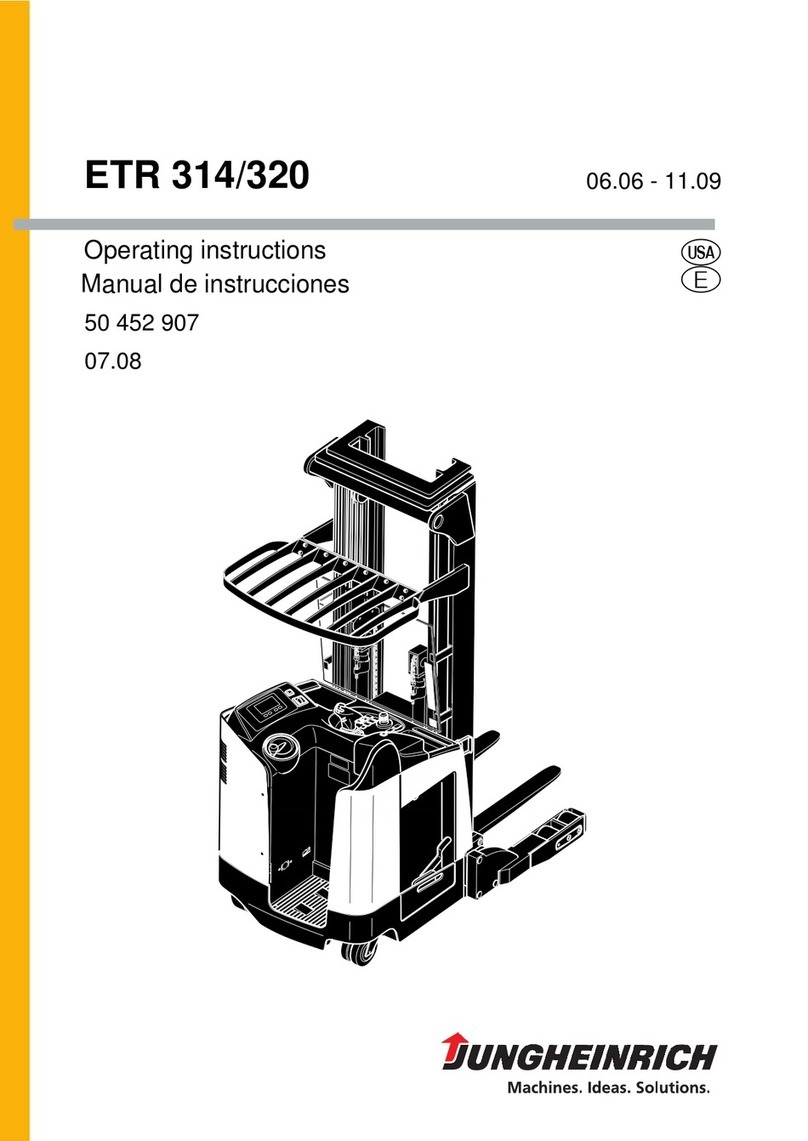
Jungheinrich
Jungheinrich ETR 314 operating instructions

Mitsubishi
Mitsubishi FGC18K Service manual
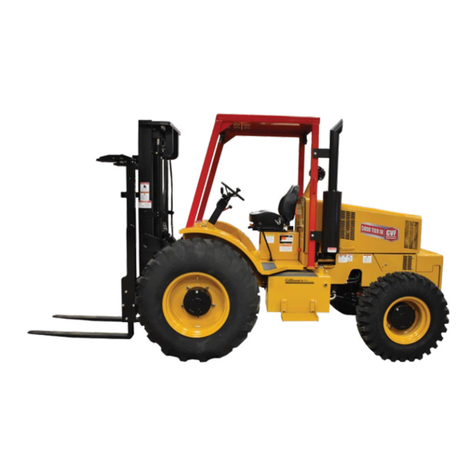
Gillison's Variety Fabrication
Gillison's Variety Fabrication Tier IV GL 11491 owner's manual
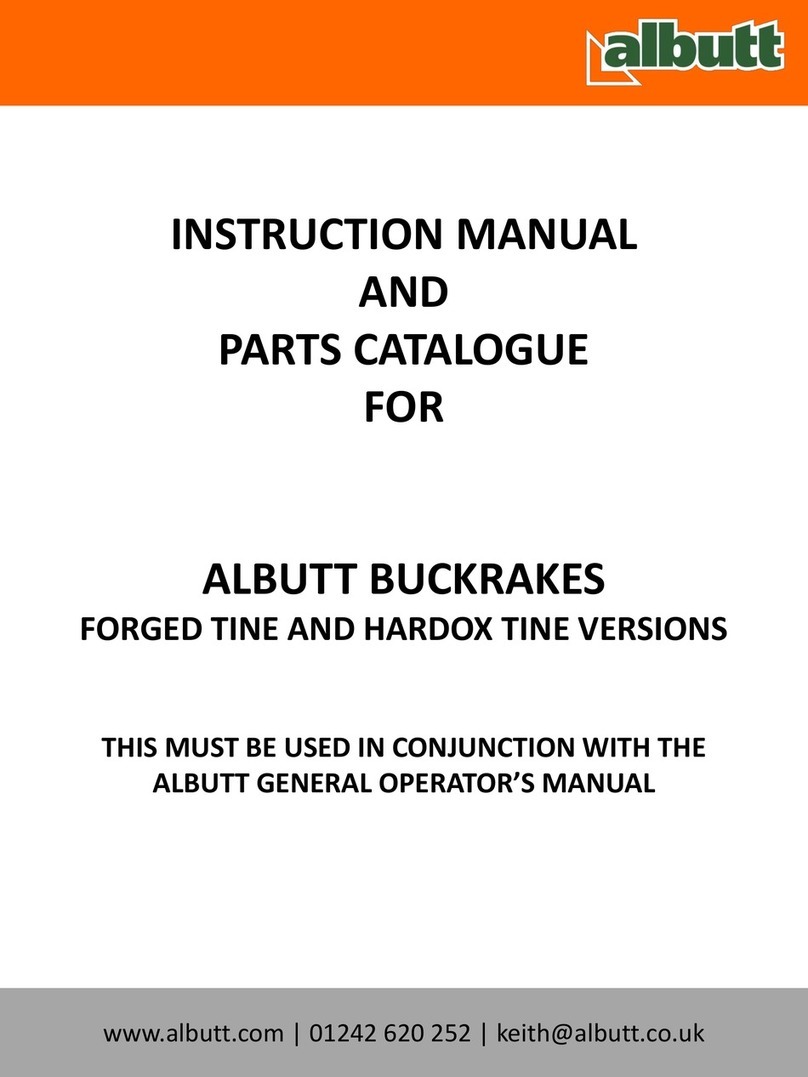
albutt
albutt FORGED TINE Series INSTRUCTION MANUAL AND PARTS CATALOGUE

Princeton
Princeton Truck Mounted Forklift Operator's manual
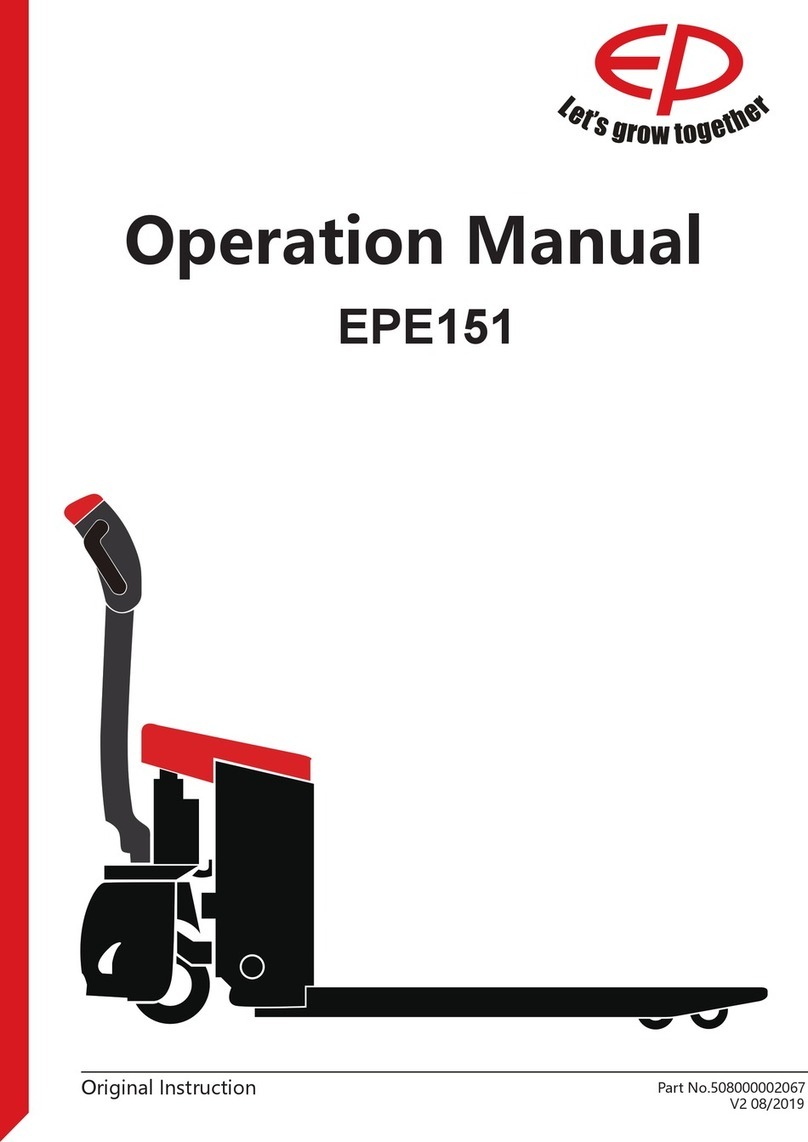
EP Equipment
EP Equipment EPE151 Operation manual

